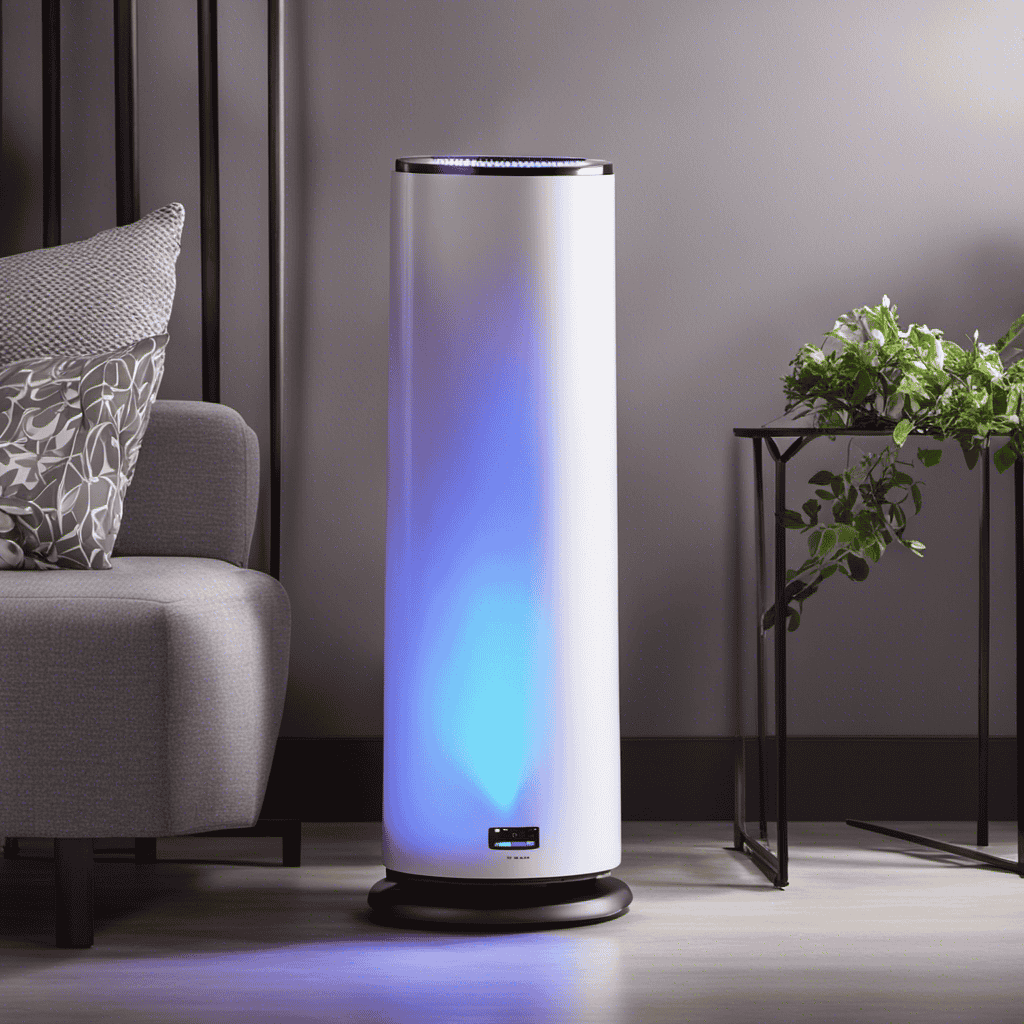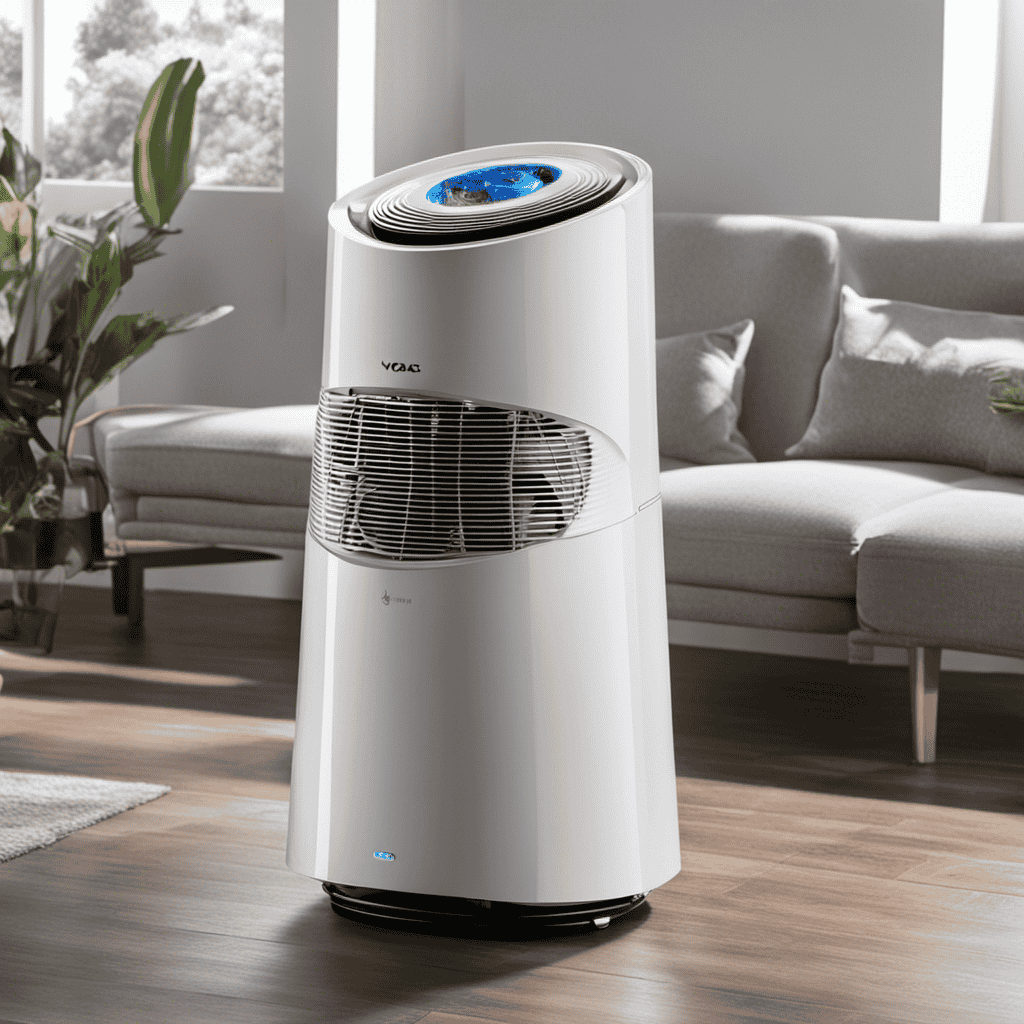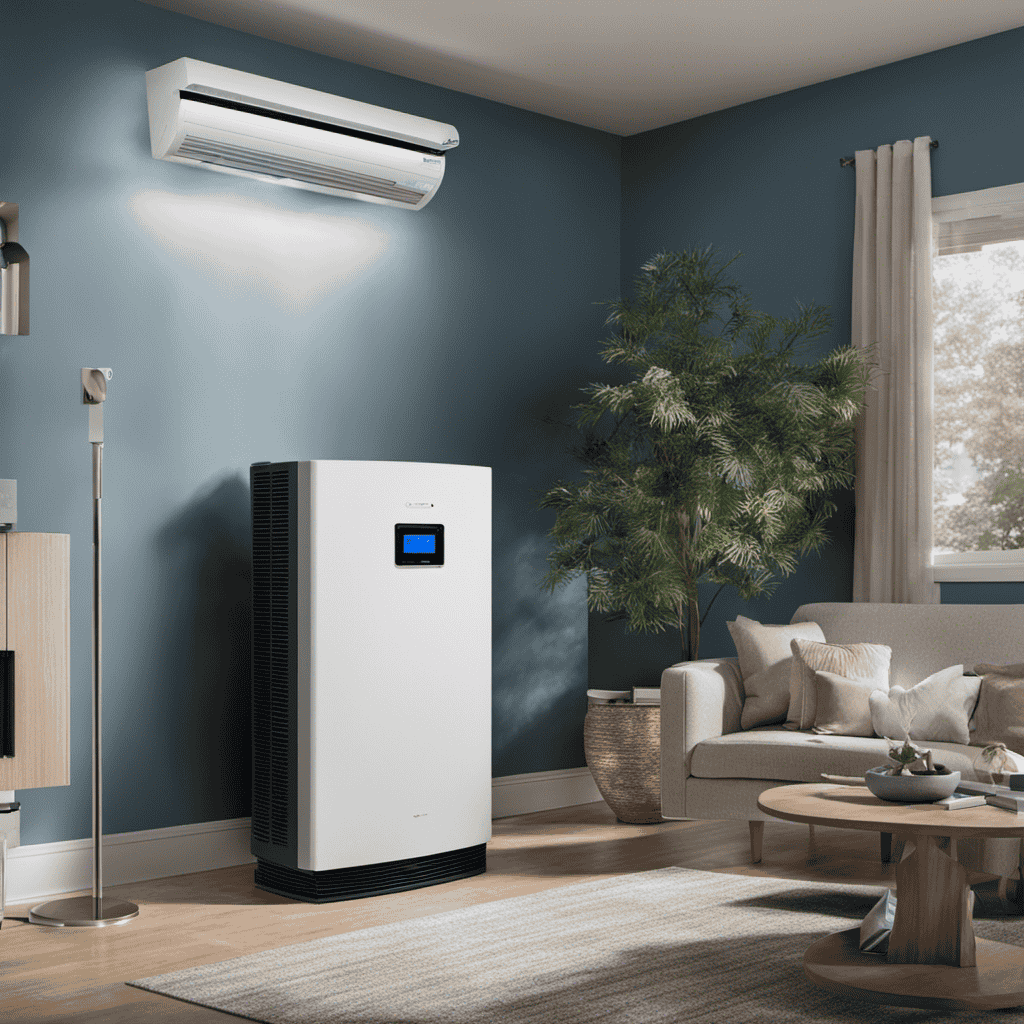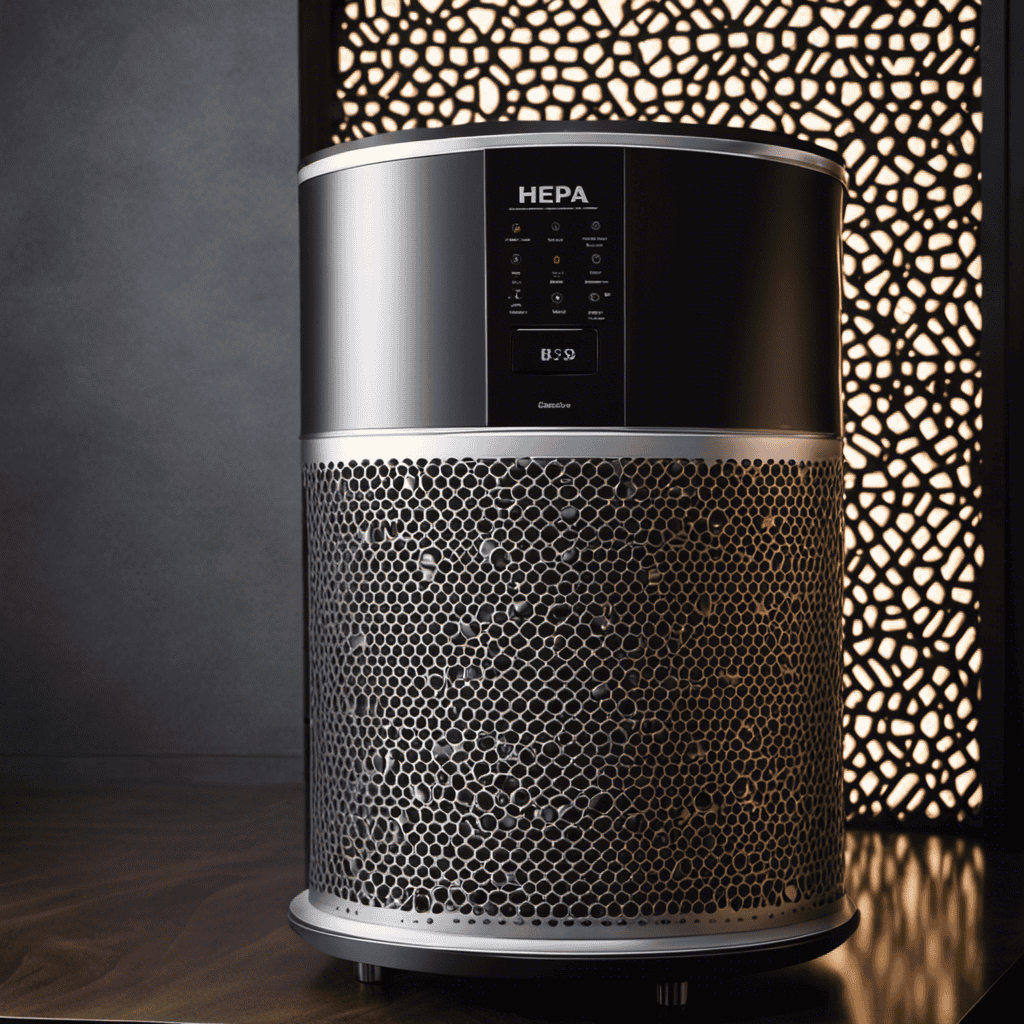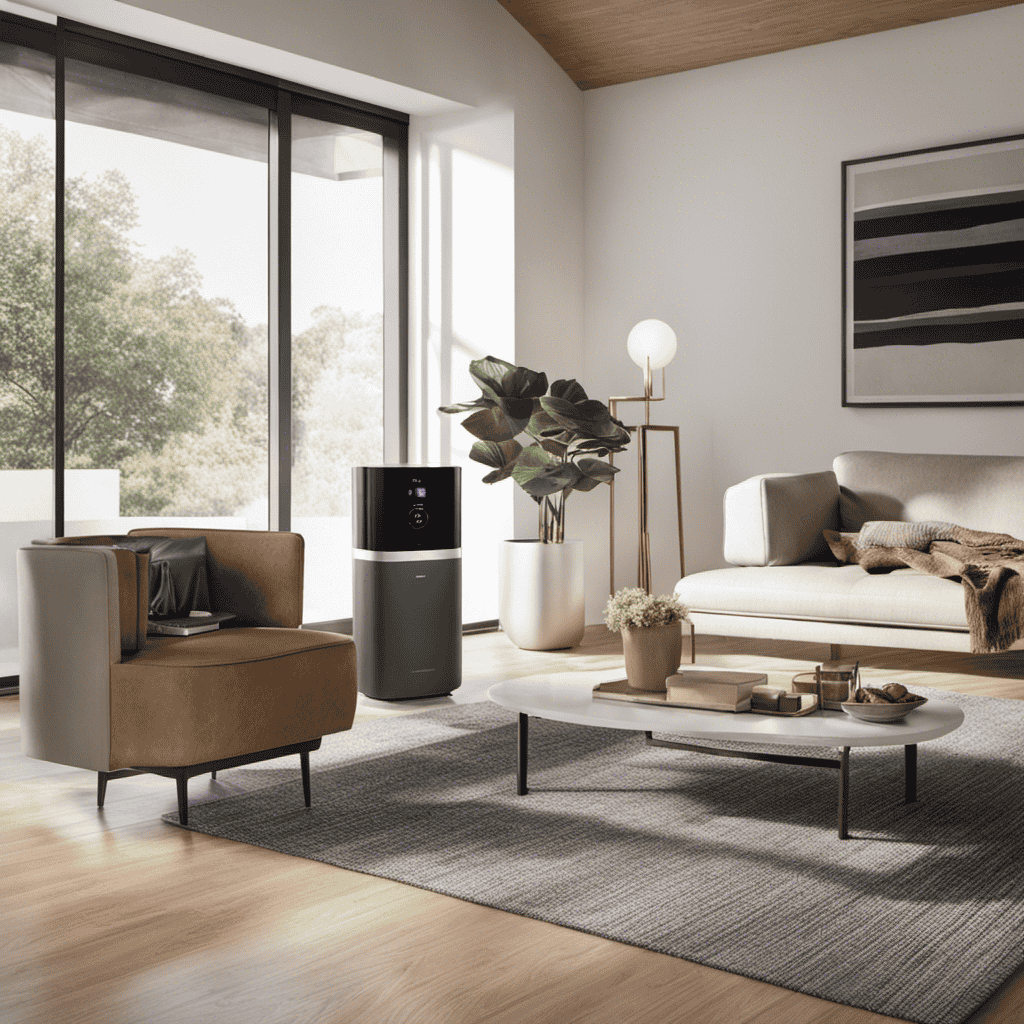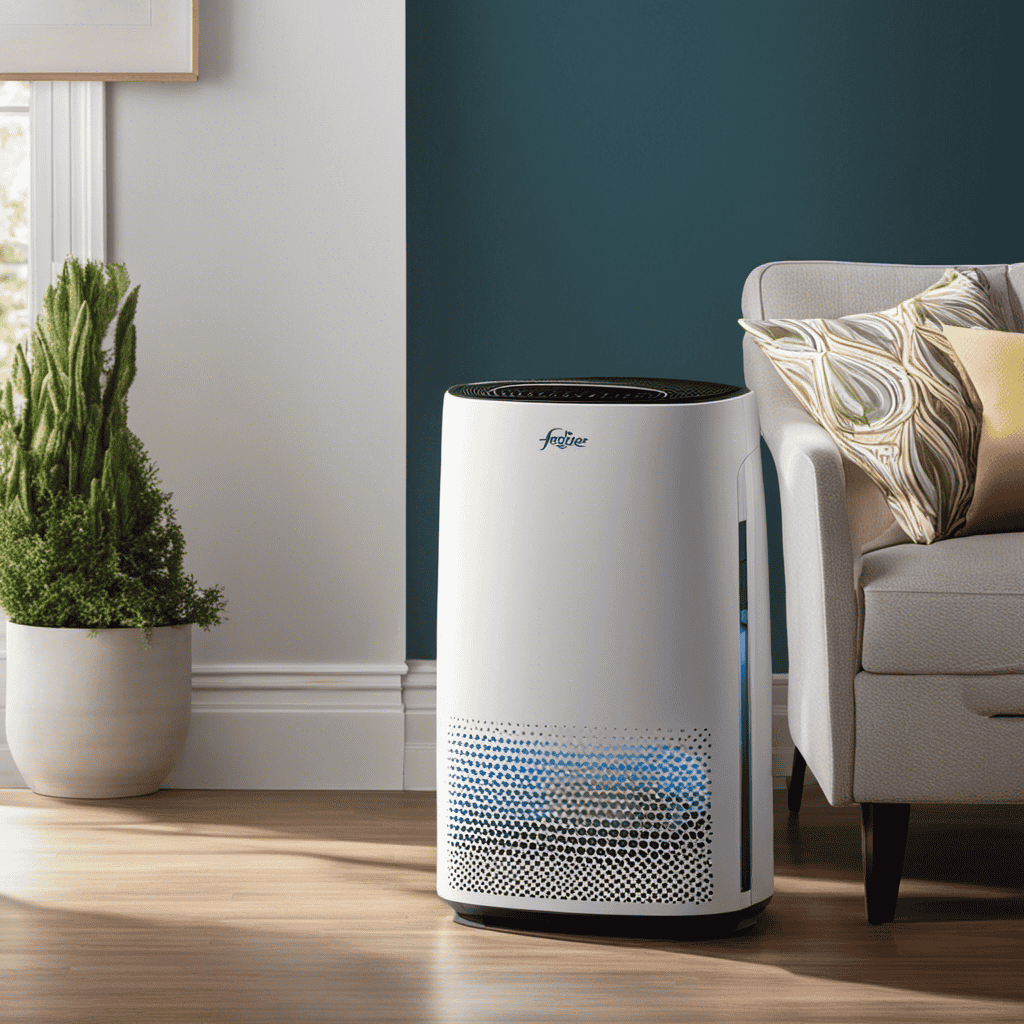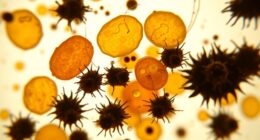Envision breathing in air that’s as pristine and revitalizing as a cool gust on a sweltering summer day. That’s precisely the experience provided by UV VOC air purifiers.
In this article, I will guide you through the world of UV VOC air purifiers, explaining how they work and why they are crucial for maintaining healthy indoor air quality.
We will explore the benefits of using UV VOC air purifiers and provide tips on choosing the right one for your specific needs. Additionally, I will share insights on how to properly maintain and clean these remarkable devices.
Get ready to discover the key to breathing in nothing but the best air.
Key Takeaways
- UV VOC technology in air purifiers eliminates harmful volatile organic compounds (VOCs) found in household products, cleaning chemicals, paints, and furniture.
- UV technology neutralizes harmful particles in the air by breaking down VOCs at a molecular level and disrupting the DNA and RNA of microorganisms.
- Effective VOC removal can be achieved with activated carbon filters, which have a large surface area to trap VOC molecules and prevent them from circulating in the air.
- UV VOC air purifiers improve indoor air quality by using advanced HEPA filters to capture particles, activated carbon filters to absorb VOCs and odors, pre-filters to prolong the lifespan of filters, and ionizers to reduce allergens and improve air quality.
The Importance of UV VOC in Air Purifiers
The UV VOC feature in air purifiers is essential for effectively eliminating harmful volatile organic compounds. These compounds can be found in various household products, such as cleaning chemicals, paints, and even furniture. UV VOC technology uses ultraviolet (UV) light to break down these compounds and render them harmless.
The role of UV C light in air purification is to provide a powerful and efficient method of destroying VOCs at a molecular level. By exposing the air to UV C light, the VOCs are broken down into non-toxic byproducts.
The benefits of VOC removal in air purifiers include improved air quality, reduced health risks, and a more pleasant living environment.
Now let’s explore how UV technology works in air purifiers and further understand its effectiveness in eliminating airborne pollutants.
How UV Technology Works in Air Purifiers
One way air purifiers work is by using UV technology to neutralize harmful particles. UV light air purifiers are designed to target and destroy microorganisms, such as bacteria and viruses, that may be present in the air. The UV light emitted by these purifiers disrupts the DNA and RNA of these microorganisms, rendering them inactive and unable to reproduce. UV technology has several benefits in air purifiers. It is highly effective in eliminating airborne pathogens, improving the overall air quality. Additionally, UV light air purifiers do not produce any harmful byproducts or chemicals, making them safe for use in various environments. The table below summarizes the benefits of UV technology in air purifiers.
| UV Technology Benefits |
|---|
| Eliminates airborne pathogens |
| Improves air quality |
| Safe and chemical-free |
Understanding VOCs and their impact on indoor air quality will be discussed in the next section.
Understanding Vocs and Their Impact on Indoor Air Quality
When it comes to indoor air quality, volatile organic compounds (VOCs) can pose significant health risks. These compounds, commonly found in household products, building materials, and even furnishings, can release harmful chemicals into the air we breathe.
Understanding the potential health risks associated with VOCs and implementing effective methods for their removal is crucial in creating a safe and healthy indoor environment.
Vocs and Health Risks
You should be aware of the health risks associated with VOCs in the air. VOC exposure can result in various health problems, including eye, nose, and throat irritation, headaches, dizziness, and difficulty breathing. Long-term exposure to VOCs has been linked to more serious health issues such as asthma, allergies, and even cancer.
VOCs are commonly found in household products, building materials, and everyday items like paints, cleaning agents, and furniture. When these products are used or stored indoors, they can release VOCs into the air, contributing to indoor air pollution. It is important to minimize VOC exposure by using low VOC or VOC-free products, ensuring proper ventilation, and regularly monitoring indoor air quality.
Transitioning into the subsequent section about ‘effective VOC removal,’ it is crucial to understand the importance of using air purifiers specifically designed to remove VOCs from the air.
Effective VOC Removal
Using an activated carbon filter is an effective method for removing VOCs from the air. This technology is widely used in air purifiers to improve indoor air quality. Here are some key points about the effectiveness of VOC removal using activated carbon filters:
- Activated carbon filters have a large surface area that can trap and adsorb VOC molecules.
- The porous structure of activated carbon provides ample space for VOCs to be trapped, preventing them from circulating in the air.
- Activated carbon filters can effectively remove a wide range of VOCs, including chemicals emitted from household products, building materials, and even tobacco smoke.
- Regular maintenance and replacement of activated carbon filters are important to ensure the continued effectiveness of VOC removal.
Benefits of UV VOC Air Purifiers
When it comes to improving indoor air quality, one of the most effective solutions is the use of UV VOC air purifiers. These devices utilize ultraviolet light to eliminate harmful chemicals and toxins present in the air, creating a healthier breathing environment.
Improved Indoor Air Quality
The air purifier’s UV VOC technology helps to improve indoor air quality. This technology is designed to target and eliminate volatile organic compounds (VOCs), which are harmful pollutants commonly found in indoor environments. By utilizing UV light, the air purifier neutralizes VOCs, reducing their concentration in the air and creating a healthier living space.
Here are some key features of the air purifier’s improved filtration system:
-
Advanced HEPA filters: These filters effectively capture and remove particles as small as 0.3 microns, including allergens, dust, and pet dander.
-
Activated carbon filters: These filters absorb and trap VOCs, odors, and other gaseous pollutants, improving the overall air quality.
-
Pre-filters: These filters capture larger particles, prolonging the lifespan of the HEPA and carbon filters.
-
Ionizers: These devices emit negative ions that attach to airborne particles, causing them to fall to the ground, reducing allergens and improving air quality.
With these features, the air purifier with UV VOC technology provides a comprehensive solution for reducing allergens and improving indoor air quality.
Eliminates Harmful Chemicals
To eliminate harmful chemicals from your indoor environment, rely on this advanced technology in the air purifier. Air purification methods have come a long way in recent years, and one of the most effective ways to eliminate toxins is through the use of UV VOC technology.
This technology utilizes ultraviolet light to break down volatile organic compounds (VOCs) and harmful chemicals that may be present in the air. When these compounds are exposed to the UV light, they are broken down into harmless byproducts, resulting in cleaner and healthier air.
Healthier Breathing Environment
Ensure that your indoor environment is healthier and promotes better breathing by incorporating advanced technology that eliminates harmful chemicals. With the increasing levels of air pollution, it is crucial to have proper ventilation systems in place to maintain a clean and fresh environment.
Here are some ways to achieve a healthier breathing environment:
- Install high-quality air purifiers that utilize UV-VOC technology to effectively eliminate volatile organic compounds (VOCs) from the air.
- Regularly maintain and clean your ventilation systems to prevent the accumulation of dust and other pollutants.
- Use natural cleaning products that are free from harsh chemicals, reducing the release of harmful pollutants into the air.
- Keep indoor plants, as they act as natural air purifiers by absorbing carbon dioxide and releasing oxygen.
Choosing the Right UV VOC Air Purifier for Your Needs
When selecting the right UV VOC air purifier for your needs, consider the size of the room and the level of air pollution.
Choosing the right UV VOC air purifier is crucial in ensuring that you effectively remove volatile organic compounds (VOCs) and other harmful pollutants from your indoor air.
UV VOC technology utilizes ultraviolet light to break down and destroy VOC molecules, improving the overall air quality in your home or office. Understanding UV VOC technology is important in making an informed decision.
Look for air purifiers that have a high UV lamp intensity and a long lamp life to ensure maximum efficiency. Additionally, consider the coverage area and the air exchange rate of the purifier to ensure it can effectively clean the air in your specific room size.
By carefully considering these factors, you can choose the right UV VOC air purifier to meet your needs and improve the air quality in your space.
Now let’s move on to the next section, where we will discuss maintaining and cleaning UV VOC air purifiers.
Maintaining and Cleaning UV VOC Air Purifiers
Now that you’ve chosen the right UV VOC air purifier for your needs, it’s important to understand how to properly maintain and clean it. Regular maintenance and cleaning will help ensure that your air purifier continues to effectively remove volatile organic compounds (VOCs) and maintain its UV sterilization capabilities.
Here are some key steps to consider:
- Clean or replace the filters regularly to prevent buildup of dust and debris.
- Wipe down the exterior of the air purifier with a damp cloth to remove any dust or dirt.
- Clean the UV lamp according to the manufacturer’s instructions to maintain its effectiveness in killing bacteria and viruses.
- Keep an eye on the indicator lights or alerts on your air purifier to know when it’s time for maintenance or filter replacement.
Following these maintenance and cleaning practices will help maximize the performance of your UV VOC air purifier and ensure clean and healthy air in your space.
Frequently Asked Questions
Are UV VOC Air Purifiers Effective in Eliminating All Types of Volatile Organic Compounds (VOCs)?
Yes, UV VOC air purifiers are effective in reducing indoor air pollution caused by volatile organic compounds (VOCs). Compared to other types of air purifiers, they utilize UV technology to neutralize VOCs and improve air quality.
Can UV VOC Air Purifiers Remove Odors Caused by VOCs?
UV VOC air purifiers are incredibly effective at removing odors caused by VOCs. They outperform other types of air purifiers in odor removal, thanks to their advanced UV technology. VOC odors don’t stand a chance against them!
How Long Does It Take for a UV VOC Air Purifier to Completely Eliminate VOCs From the Air?
The elimination time of VOCs in the air using a UV VOC air purifier can vary depending on factors like concentration and airflow. However, it’s important to note that the effectiveness of these purifiers may have limits in completely removing VOCs.
Are UV VOC Air Purifiers Safe to Use in Homes With Pets or Children?
UV VOC air purifiers are safe for homes with pets or children. They effectively reduce potential health risks by eliminating volatile organic compounds. Compared to other purifiers, UV VOCs provide thorough and technical purification.
Can UV VOC Air Purifiers Also Filter Out Other Pollutants Such as Dust, Pollen, and Bacteria?
UV VOC air purifiers are efficient in reducing indoor allergens like dust, pollen, and bacteria. When compared to other air purification technologies, they provide effective filtration. However, it’s important to consider specific product specifications and features for the best results.
Is Uv Voc in Air Purifier the Same as Vac in Air Purifier?
Uv Voc in air purifiers is not the same as vac in air purifiers. Uv Voc focuses on removing volatile organic compounds, while vac is about vacuuming air purifier filters to maintain their efficiency. Both are important for clean indoor air, but they serve different purposes.
Conclusion
In conclusion, UV VOC air purifiers play a crucial role in improving indoor air quality. They effectively eliminate volatile organic compounds using UV technology. By breaking down and neutralizing harmful VOCs, these purifiers ensure a safer and healthier environment for you and your loved ones.
While some may argue that UV VOC air purifiers are expensive, it is important to consider the long-term benefits they provide. These purifiers can reduce the risk of respiratory issues and allergies. Investing in a quality UV VOC air purifier is a wise decision for anyone looking to breathe cleaner air.
